Basic Fender Electric Guitar Setup
By Bobby Brooks
If your guitar is not playing at the correct pitch, especially while playing up the neck, you may need to set your guitar's
intonation. A good guitar setup will lend to greater playing comfort if the string height is better adjusted to the fretboard
and will give better intonation from the open string down the entire length of the fretboard, and in addition will help eliminate
string buzz caused by the strings being too low to the fretboard; also referred to as adjusting the string's action.
The string's action is the distance between the top of the frets and the bottom of the strings. Most guitar players want their
guitar's action to be as low as possible without causing the strings to "buzz" against the unfretted frets. Setting the guitar's
action often depends on your playing style and your personal preferences.
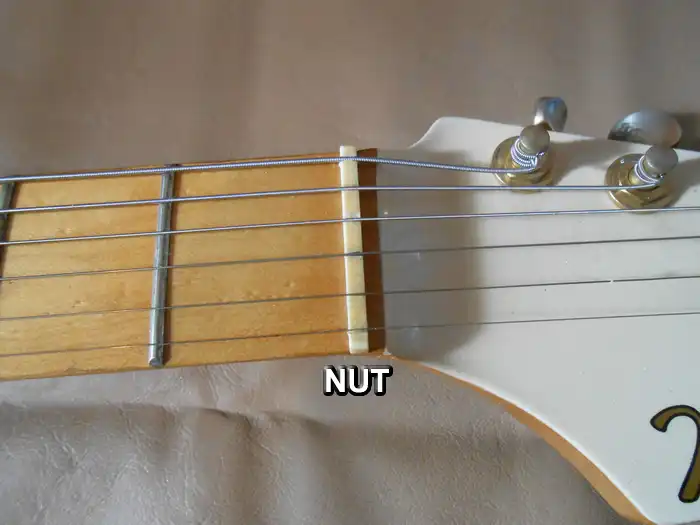
Different guitars require different setups, and there are guitars that cannot be set up, their saddles and bridges are permanently
fixed in one position, and therefore intonation should be checked before purchasing the instrument, and changing the guitar's
strings with different gauged strings could impact intonation!
Tools you may need and want - make sure you use the correct sized tools:
Phillips screwdriver / Flathead screwdriver (for older style truss rod)
Allen wrenches or socket wrenches for truss rod and bridge
Feeler gauges
Electronic Tuner
Capo
Always re-tune after adjusting and make sure your follow up measurements are accurate.
Phillips screwdriver / Flathead screwdriver (for older style truss rod)
Allen wrenches or socket wrenches for truss rod and bridge
Feeler gauges
Electronic Tuner
Capo
Always re-tune after adjusting and make sure your follow up measurements are accurate.
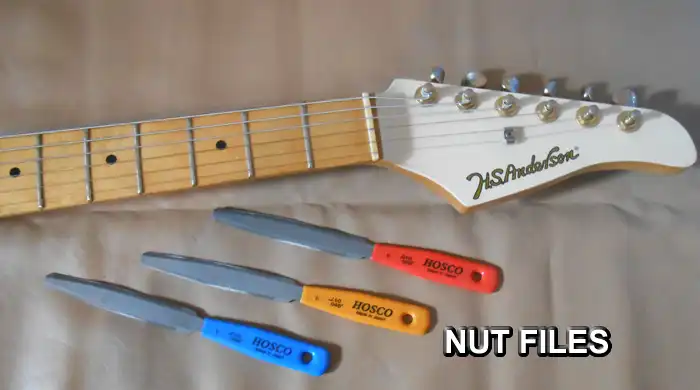
When setting up your guitar you want to first check the height if the nut. I spent countless hours trying to setup proper
intonation; I set the saddles as far back as possible and I still was not getting proper intonation at the 12th fret, only to
realize after much investigation that the nut had not been and often are not properly cut from the factory. If you are not sure
what the guitar nut is check out basic guitar anatomy.
To check the height of the nut first press down on the strings at the third fret, using a capo at the third fret will make the
task easier. A feeler gauge between 0.15 and 0.20mm should pass through at the first fret on an electric guitar without touching
either the string or the fret. If the string touches or if the gap is too great, then the nut setup is incorrect.

The next step is checking the neck curvature against a string gauge and making sure the neck bow is sufficient and not too flat
or too bowed; and adjusting the truss rode if needed - a neck should never be completely flat. On an electric guitar press down
on the strings at the first fret and at the fifteenth fret at the same time using a capo or capos, if possible, and check the
height of the strings at the seventh fret. The height at the seventh fret should be between 0.10 to 0.25mm.
The truss rod is typically a single action or dual-action metal bar or graphite bar which runs the length of the neck giving the
neck resistance against hundreds of pounds of pressure inserted by the guitar's strings. Single action truss rods are threaded on
one end which allows you to turn the bar to increase or decrease the pressure against the pressure of the strings. A double-sided
threaded bar allows you to increase or decrease the tension of the strings before running out of adjustment. If the guitar is
bowed backwards the strings will be too close to the fretboard and buzz in the middle of the fretboard.
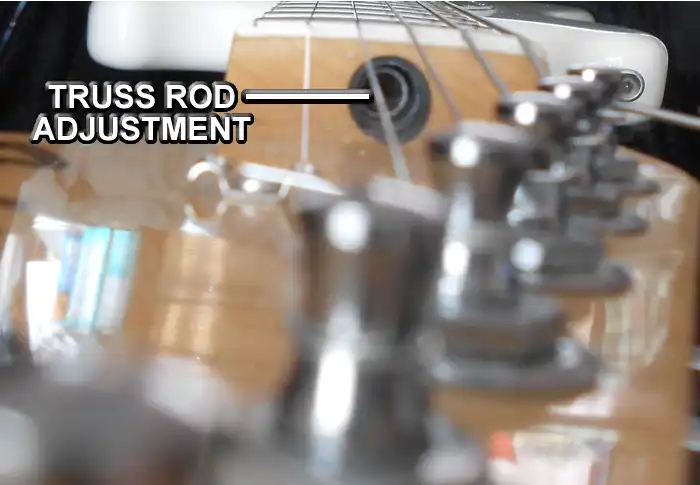
If the gap is too large you will need to tighten the truss rod to increase the bow in the middle which will bring the strings
closer together; and if the gap isn't great enough for the feeler gauge to pass through freely you will need to loosen the neck
curvature by loosening the truss rod. If needed, check the guitar anatomy to locate the truss rod.
To increase relief, you will want to loosen the truss rod by turning it counterclockwise, and by turning the truss rod clockwise
you will decrease the relief and tighten the truss rod. An adjustment should be done turning the truss rod only about a quarter
of a turn at a time and always tune the guitar after each adjustment to insure proper tension to correctly check the adjustment.
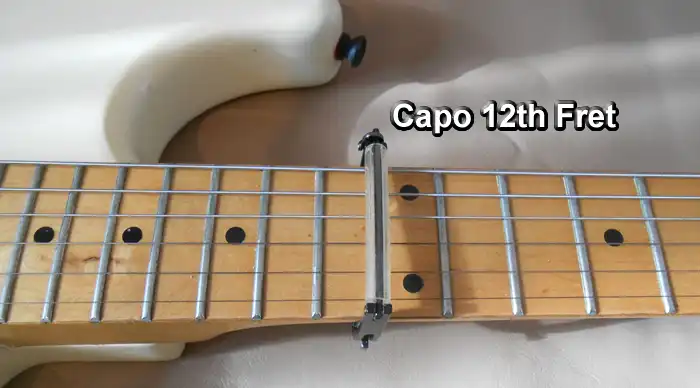
Do not force the truss rod! If you are having trouble moving the truss rod the rod could be turned as far as it can be adjusted.
If this is the case, you will want to take the instrument to a qualified luthier. In some cases, the guitar may need to settle
overnight after an adjustment to insure you are not over-tightening the truss rod.
The third step is adjusting the bridge height. On an electric guitar the gap at the twelfth fret between the string and the fret
should be about 1.8mm on the low E-string and 1.4mm on the high E side. You can adjust the saddle height for each string by
adjusting the two setscrews on each side of the strings: thus, lowering or raising the guitar's action.
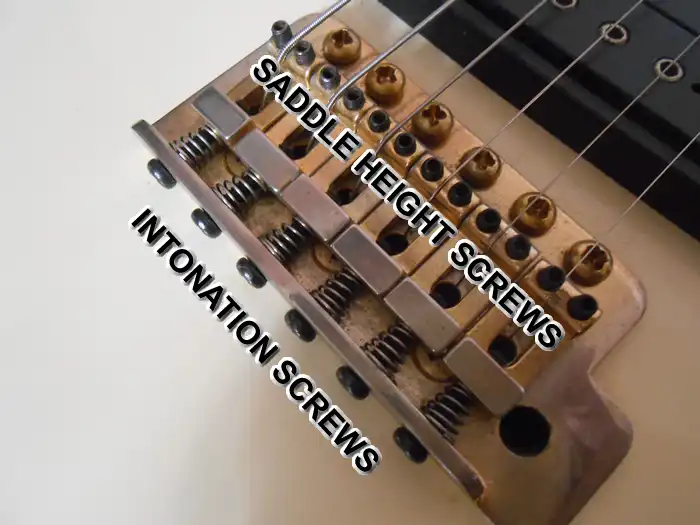
Adjusting the saddle height higher will increase the string tension thus making it more difficult to bend the strings while
playing; therefore, it is advisable to adjust the height according to your playing style as well as for comfort and intonation.
The fourth step is adjusting the saddle depth, which is either moving the saddles away from the back of the guitar or towards the
back of the guitar. If the fretted note is flat, adjust the saddle towards the neck. If the fretted note is sharp, adjust the
saddle back towards the bridge. Remember - flat forward, sharp back!
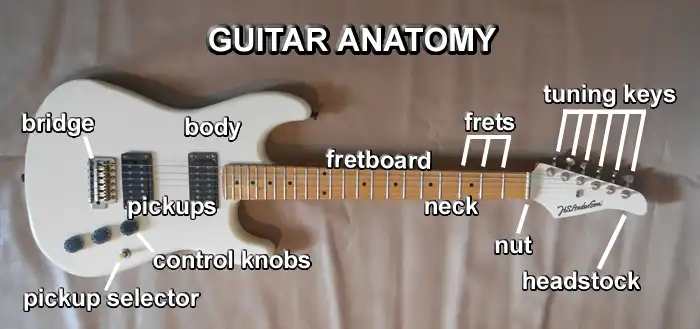
Start by tuning the six strings on your guitar to their proper tune using an electronic guitar tuner. Once in tune starting at
the twelfth fret low E-string check and make sure the string is still in tune. If the note on the twelfth fret against the same
string in open position is too high, it means the saddle needs moved back towards the back of the guitar and if it is too low it
will need to be moved forward away from the back of the guitar.
Do not strip the screw heads when adjusting intonation; you may need to loosen the string tension when moving the saddles forward.
Turn the screws incrementally until you determine the required pitch adjustment. A proper guitar setup is not an easy task, and
if often better left up to a trained guitar luthier, who can often be found at your local instrument dealer's shop.

Additional Tip: You may want to adjust the height of the pickups - the distance from the strings.
Bridge pickup = Low-E string: 2.5 mm / High-E string: 2.0 mm
Middle pickup = Low-E string: 3.0 mm / High-E string: 2.5 mm
Neck pickup = Low-E string: 3.5 mm / High-E string: 3.0 mm
Bridge pickup = Low-E string: 2.5 mm / High-E string: 2.0 mm
Middle pickup = Low-E string: 3.0 mm / High-E string: 2.5 mm
Neck pickup = Low-E string: 3.5 mm / High-E string: 3.0 mm
Add Comment
Insert Bullet List
Please enter at least one item.
Item:
Item:
Item:
Item:
Item:
Insert Numeric List
Please enter at least one item.
Item:
Item:
Item:
Item:
Item:
Insert Link
Please enter the link of the website
Optionally you can add display text
Insert Email
Please enter the email address
Optionally add any display text
Insert Image
Please enter the link of the image
Insert YouTube Video
Please enter the link of the video
Image Upload
Privacy Policy
This policy contains information about your privacy. By posting, you are declaring that you understand this policy:
- Your name, rating, website address, town, country, state and comment will be publicly displayed if entered.
- Aside from the data entered into these form fields, other stored data about your comment will include:
- Your IP address (not displayed)
- The time/date of your submission (displayed)
- Your email address will not be shared. It is collected for only two reasons:
- Administrative purposes, should a need to contact you arise.
- To inform you of new comments, should you subscribe to receive notifications.
- A cookie may be set on your computer. This is used to remember your inputs. It will expire by itself.
This policy is subject to change at any time and without notice.
Terms and Conditions
These terms and conditions contain rules about posting comments. By submitting a comment, you are declaring that you agree with these rules:
- Although the administrator will attempt to moderate comments, it is impossible for every comment to have been moderated at any given time.
- You acknowledge that all comments express the views and opinions of the original author and not those of the administrator.
- You agree not to post any material which is knowingly false, obscene, hateful, threatening, harassing or invasive of a person's privacy.
- The administrator has the right to edit, move or remove any comment for any reason and without notice.
Failure to comply with these rules may result in being banned from submitting further comments.
These terms and conditions are subject to change at any time and without notice.
{"commentics_url":"\/\/skoukor.com\/cmt\/","page_id":352,"enabled_country":true,"country_id":0,"enabled_state":true,"state_id":0,"enabled_upload":true,"maximum_upload_amount":3,"maximum_upload_size":5,"maximum_upload_total":5,"captcha":false,"captcha_url":"","cmtx_wait_for_comment":"cmtx_wait_for_comment","lang_error_file_num":"A maximum of %d files are allowed to be uploaded","lang_error_file_size":"Please upload files no bigger than %.1f MB in size","lang_error_file_total":"The total size of all files must be less than %.1f MB","lang_error_file_type":"Only image file types are allowed to be uploaded","lang_text_loading":"Loading ..","lang_placeholder_country":"Country","lang_placeholder_state":"State","lang_text_country_first":"Please select a country first","lang_button_submit":"Add Comment","lang_button_preview":"Preview","lang_button_remove":"Remove","lang_button_processing":"Please Wait.."}
{"commentics_url":"\/\/skoukor.com\/cmt\/","language":"english"}
|
Copyright © Skoukor Music 2025
|
||

|
||


Comments